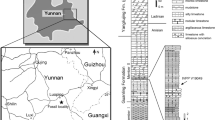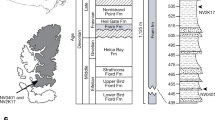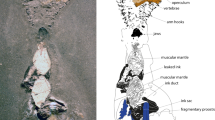Abstract
THE recent discovery in the Southern Hemisphere (15.5 °S) of a walrus-like skull of a toothed whale (odontocete) from the Pisco Formation of southern Peru presents a startling example of convergence and specialization unprecedented among cetaceans. In contrast to other toothed whales, Odobenocetops peruvianus has no elongated rostrum but has large, ventrally directed premaxillary alveolar processes housing asymmetrical tusks. The dorsally facing orbits indicate the possibility of dorsal binocular vision which could compensate for the absence of the melon, a rostral organ involved in echolocation. Strong muscle scars on the anterior edge of the premaxillae suggest the presence of a powerful upper lip. It is this feature, together with the morphology of the deep vaulted palate devoid of maxillary teeth, that enables us to hypothesize a convergent feeding adaptation with the walrus which feeds mainly on thin-shelled bivalve molluscs, sucking out the foot and/or siphon and ejecting the shell. The structure of the face and basicranium indicates it was a delphinoid cetacean, probably related to the living beluga and narwhal (Monodontidae).
This is a preview of subscription content, access via your institution
Access options
Subscribe to this journal
Receive 51 print issues and online access
$199.00 per year
only $3.90 per issue
Buy this article
- Purchase on Springer Link
- Instant access to full article PDF
Prices may be subject to local taxes which are calculated during checkout
Similar content being viewed by others
References
Hoffstetter, R. G. r. hebd. Acad. Sci. Paris sér. D267, 1273–1276 (1968).
Marocco, R. & de Muizon, C. Géodynamique 3, 3–19 (1988).
Marocco, R. & de Muizon, C. Bull. Inst. Fr. Ét. Andines 27, 105–117 (1988).
Dunbar, R. B., Marty, R. C. & Baker, P. A. Palaeogeogr. Palaeoclimatol. Palaeoecol. 77, 235–261 (1990).
Pilleri, G. Beiträge zur Paläontologie der Cetaceen Perus (Hirnanatomisches Institut, Ostermundigen, Bern, Switzerland) I, 1–233 (1989); II, 1–248 (1990).
de Muizon, C. & DeVries, T. J. Geol. Rdsch. 74, 547–563 (1985).
de Muizon, C. Éd. Rech. gr. Civilisations, mém. 6, 1–150 (Trav. Inst. Fr. Ét. Andines 22) (1981).
de Muizon, C. Éd. Rech. Civilisations, mém. 78, 1–244 (Trav. Inst. Fr. Ét. Andines 42) (1988).
de Muizon, C. Éd. Rech. Civilisations, mém. 50, 1–188 (Trav. Inst. Fr. Ét. Andines 27) (1984).
Deméré, T. A. J. Paleont. 10 (suppl.), 20A (abstract 48), (1990).
Fay, F. H. N. Am. Fauna 74, 1–279 (1982).
Kastelein, R. A. & Mosterd, P. Aquatic Mammals 15, 3–5 (1989).
Mead, J. G. Smithson. Contr. Zool. 207, 1–72 (1975).
DeVries, T. J. in Cenozoic Geology of the Pisco Basin Regional IGCP156 Field Workshop Genesis of Cenozoic Phosphorites and Associated Organic-rich Sediments: Peruvian Continental Margin (eds Dunbar, R. B. & Baker, P. A.) 127–134 (Lima, Peru, 1988).
Carriol, R. P., de Muizon, C. & Secrétan, S. Annls Paleont. 73, 137–164 (1987).
Oliver, J. S., Slattery, P. N., O'Connor, E. F. & Lowry, L. F. Fish. Bull. F.A.O. 81, 501–512 (1983).
Ray, C. in Whales Dolphins and Porpoises (ed. Norris, K. S.) Part IV, 671 (University of California Press, Los Angeles, 1966).
Heyning, J. E. & Mead, J. G. 9th Biennial Conf. Biol. Marine Mammals, Chicago 5–9 Dec. 1991, Abstracts p. 33.
Werth, A. J. 9th Biennial Conf. Biol. Marine Mammals, Chicago 5–9 Dec. 1991, Abstracts p. 73.
Perrin, W. F. & Myrick, A. C. Jr Rep. Int. Whal. Comm. Spec. Iss. 3, 1–229 (1980).
Bourdelle, E. & Grassé, P.-P. in Traité de Zoologie (Masson Eds, Paris, 1955), 27, 341–350.
Barnes, L. G. in The Bottlenose Dolphin (eds Leatherwood S. & Reeves, R.) 3–26 (Academic, New York, 1990).
Heyning, J. E. Contr. Sci Nat. Hist. Mus Los Angeles County 405, 1–64 (1989).
de Muizon, C. Proc. Ser. San Diego Soc. Nat. Hist. (in the press).
de Muizon, C. Annls Paleont. 74, 115–183 (1988).
Brownell, R. L. in Handbook of Marine Mammals Vol. 4 (eds Ridgway, S. H. & Harrison, R.) 45–67 (Academic, London, 1989).
Robin, R. C. & da Silva, V. M. F. in Handbook of Marine Mammals Vol. 4 (eds Ridgway, S. H. & Harrison, R.) 1–23 (Academic, London, 1989).
Kastelein, R. A. & van Gaalen, M. A. Aquatic Mammals 14, 123–133 (1988).
Kastelein, R. A., Stevens, S. & Mosterd, P. Aquatic Mammals 16, 78–87 (1990).
Author information
Authors and Affiliations
Rights and permissions
About this article
Cite this article
de Muizon, C. Walrus-like feeding adaptation in a new cetacean from the Pliocene of Peru. Nature 365, 745–748 (1993). https://doi.org/10.1038/365745a0
Received:
Accepted:
Issue Date:
DOI: https://doi.org/10.1038/365745a0
This article is cited by
-
Tempos and modes of collectivity in the history of life
Theory in Biosciences (2021)
-
Juvenile morphology in baleen whale phylogeny
Naturwissenschaften (2014)
-
An aquatic sloth from the Pliocene of Peru
Nature (1995)
Comments
By submitting a comment you agree to abide by our Terms and Community Guidelines. If you find something abusive or that does not comply with our terms or guidelines please flag it as inappropriate.



